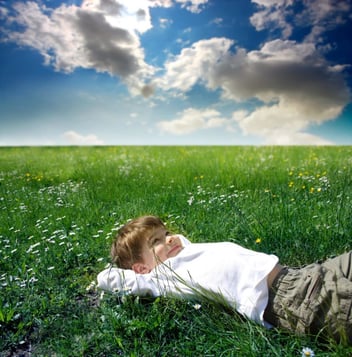In the Wake of Fire: Caring for California’s Children

By Marysa Enis and Maria Gregory
It’s been a traumatic week for California school children. There is no escaping the mood or hazy sky. There is no escaping the ash. At best, students can still go to school, but they can’t go to recess because the air is unsafe to breathe. At worst, children are displaced, scared, and grieving. The whole country is watching. And in the space between, people are trying to make sense of something terrifying.
As you probably know, this is what a traumatic event looks like — Or, we should say, can look like. Natural disasters … war … random acts of violence. Most people recognize the key players when it comes to trauma. As a country, we’ve gotten pretty good at discussing these issues, too. News feeds are starting to include conversations about mental health and post-traumatic stress disorder (PTSD). How to recognize signs and symptoms. How to support those in need, most notably our veterans.
But for educators and parents, there is more to the story than these big-picture issues. Caring for children is hard, and caring for children in crisis can feel downright impossible. So today, in support of California parents, educators, and children, we turn the conversation to trauma-informed care of kids.
The Nature of Trauma
Most people think of trauma as something acute, obvious, and rare. Perhaps it’s a single terrifying event, or maybe a prolonged period of abuse, that sticks with a person forever. Unfortunately, the true nature of trauma is more complex and prevalent.
In this article about trauma in children, the American Psychological Association gives disconcerting news: Across community samples, two-thirds of our children have been exposed to a traumatic event.
Actually, scratch that.
More than two-thirds of children. And, in all likelihood, more than one traumatic event. Right now, thousands of children in California are among them.
The odd and unexpected thing about trauma, though, is that there is no way to predict how any one person will respond to any one event. What may become life-altering for one child may become a fading memory for another. And why is that? Because (and you won’t be surprised here) each child is unique, and part of that uniqueness is the culmination of each child’s personal experience.
For children, these experiences include things like access to family support, friends, basic needs (food, water, sleep, shelter), stable living conditions, good health, and medical care. In the mental health community, we call some of these protective factors (the good things that, in essence, protect a child from the bad things). We call the others Adverse Childhood Experiences (ACEs). In isolation and with ample support, a traumatic event does not have to turn into trauma. On the other hand, the more adversity in a child’s life, the more likely they are to suffer the ill-effects of trauma.
What Does This Mean for California’s Children?
Right now, children across California are in the throes of a traumatic event. Fires are still burning. People are still wearing masks. Schools are still being cancelled. And most terrifying of all, hundreds of people are still missing.
While all this is happening, each child in California is processing. We can’t tell you what they’re processing or how they’re processing it. Brains are just too different from one another for us to do that (imagine small streams of water working their way down a mountain of sand – the flow is different every time). But what we can tell you is how to care for kids during this difficult time and, hopefully, be a protective influence in their lives.
Step One: Know the ACEs
The sheer number of adverse experiences in a child’s life can predict how they will respond to current events. When working with a child, consider what experiences they bring with them.
These are some common sources of trauma for kids:
- Bullying
- Community violence
- Accidents
- Death in the family
- Parental separation/divorce
- Scarcity of resources (such as food, clothing, and electricity)
- Racial, ethnic, and linguistic discrimination
- Exposure to domestic violence or drug/alcohol abuse
- Neglect
- Health or medical problems
- Natural disasters, including the pervasive California fires
Step Two: Know What to Expect
There are expected and unexpected responses to just about anything, traumatic events included. With that in mind, caretakers can expect children to show some level of distress in the days and weeks that follow.
Common responses include:
- Development of new fears
- Separation anxiety
- Sleep disturbance, including nightmares
- Sadness
- Loss of interest in normal activities
- Reduced concentration
- Decline in school work
- Anger
- Somatic complaints
- Irritability
Step Three: Support Kids
The California Association of School Psychologists and the National Association of School Psychologists recommend the following for teachers (and we’ve sprinkled in our two cents, as well):
- Remain calm and reassuring – Lower yourself to a child’s eye-level, make eye-contact, and keep a relaxed body posture to help
- Be aware of your own needs and take care of them – It’s the same principle airlines use when they tell parents to put their life-mask on first – we can’t adequately care for others when our own needs interfere
- Acknowledge and normalize students’ feelings – Replace sayings like, “there’s nothing to worry about” or “other people have it worse,” with things like, “this is really hard, isn’t it?” or “a lot of people feel worried when there are natural disasters,” etc.
- Encourage children to talk about disaster-related events – Unless students are in immediate and obvious distress (i.e. showing signs of panic), provide opportunities for them to share their ideas. Listen carefully to their concerns or fears.
- Promote coping skills and the importance of peer support – Facilitate class discussions about what things help people feel better when they are under stress and offer opportunities for children to use these skills. Make a list of options, steps to follow, and designated “safe places” to go when children feel the need.
- Identify children who are at-risk for developing stress symptoms – (see Step One: Know the ACEs)
- Refer children for additional support as needed – Know your school’s policies and procedures for addressing the mental health needs of kids, as well as the names of people designated to help. It may be a social worker, guidance counselor, or community outreach program.
- Communicate with Parents – Parents know their children well and can offer great insight about what behavior is worrisome and what is not; what works and what doesn’t; what they can help with at home and what you can help with at school. When parents and schools are on the same page, children thrive!
Want to learn more about caring for children with trauma?
In addition to the wealth of information provided by the National Association of School Psychologists, Psyched Services recommends:
- Fostering Resilient Learners by Kristin Souers and Pete Hall
- The Body Keeps the Score by Bessel Van Der Kolk
- The Whole Brain Child and The Yes Brain by Dan Siegel
- Zones of Regulation Curriculum by Leah Kuypers
Looking for more resources and support? Contact us today for a free consultation!





